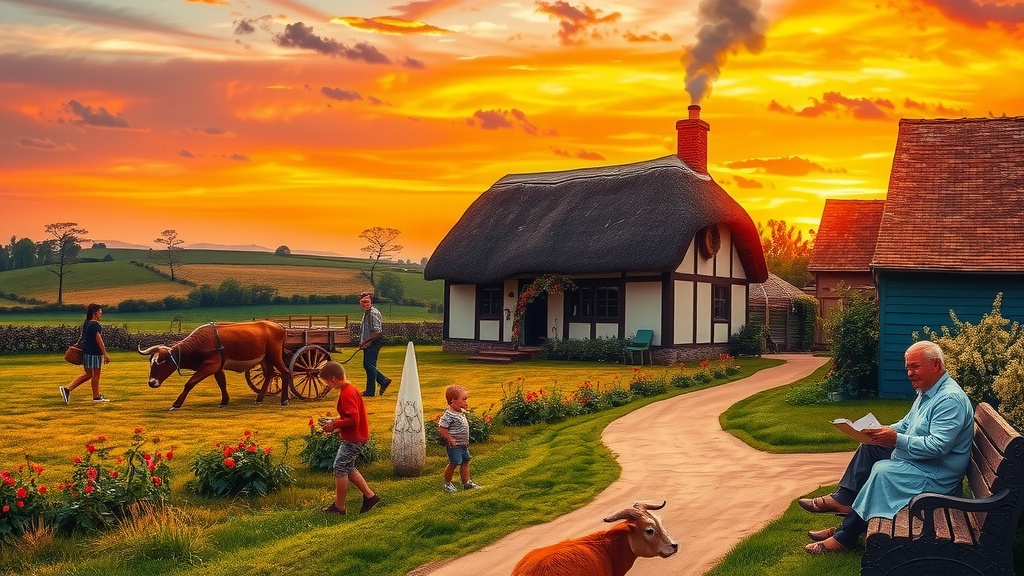In Bangladesh, a land painted with vibrant green paddy fields and crisscrossed by shimmering rivers, village life holds a special place. It’s more than just a way of living; it's a tapestry woven with strong community bonds, simple pleasures, and a deep connection to nature. From the chirping of birds at dawn to the gentle glow of lanterns at dusk, village life offers a unique perspective, a slower pace, and a richness often missed in the hustle and bustle of city life. Let's explore the heart of Bangladesh, one paragraph at a time.
The Essence of Village Life in Bangladesh
Village life in Bangladesh is characterized by its simplicity, close-knit communities, and the profound influence of nature. Imagine waking up to the sound of roosters crowing and the smell of freshly baked ruti wafting from your neighbor's kitchen. This is the daily reality for millions of Bangladeshis who call the villages their home.
Simplicity and Tranquility
Unlike the chaotic rhythm of urban existence, village life unfolds at a more deliberate pace. There's a certain tranquility that permeates the air, a sense of calm that allows people to connect with themselves and their surroundings. The absence of constant noise and the abundance of open spaces contribute to this serene atmosphere.
Community Bonds and Social Harmony
One of the most striking aspects of village life is the strong sense of community. Neighbors aren't just people who live next door; they're like family. They share joys and sorrows, help each other in times of need, and participate in communal activities like weddings, festivals, and funerals. This spirit of togetherness fosters social harmony and creates a supportive environment for everyone.
Nature's Embrace
Villages in Bangladesh are often nestled amidst lush greenery, surrounded by rice paddies, rivers, and ponds. This close proximity to nature shapes the lives of the villagers in profound ways. Agriculture is the primary occupation, and people's livelihoods are directly dependent on the bounty of the land. They have a deep respect for nature and understand the importance of living in harmony with it.
Village Life Paragraph for Class 6-12
Here are a few paragraphs tailored for different class levels, offering a glimpse into the beauty and challenges of village life in Bangladesh:
Paragraph for Class 6 (150 Words)
Village life in Bangladesh is very simple and peaceful. People live close to nature, surrounded by green fields and rivers. They wake up early to the sound of birds and spend their days working in the fields or taking care of animals. Everyone knows each other and helps each other. Children play together in the open fields, and families gather in the evenings to share stories. There are fewer cars and less noise than in the city. While life can be hard because there are not always good schools or hospitals, village life is full of love, kindness, and a strong sense of community. It is a place where traditions are valued, and people live in harmony with nature.
Paragraph for Class 7-8 (250 Words)
Life in a Bangladeshi village offers a stark contrast to the bustling cities. It's a world where the rhythm of life is dictated by the seasons and the sun. Most villagers are farmers, their days filled with cultivating rice, jute, and vegetables. The air is fresh, the sky is vast, and the nights are quiet, broken only by the sounds of crickets and distant dogs. Community plays a vital role in village life. People share their joys and sorrows, helping each other during harvests, weddings, and times of hardship. Salish, or village councils, resolve disputes and maintain harmony. While modern amenities like electricity and internet are slowly making their way into villages, challenges remain. Access to quality education and healthcare is often limited, and poverty is a persistent issue. Despite these difficulties, village life in Bangladesh retains its charm, offering a unique blend of simplicity, community, and connection to nature. The strong cultural heritage and the warmth of the people make it a truly special place.
Paragraph for Class 9-10, SSC (300 Words)
Bangladeshi villages represent the heart and soul of the nation, embodying a lifestyle deeply rooted in tradition, agriculture, and community. The majority of villagers are engaged in farming, cultivating the fertile land to produce rice, jute, and various vegetables. Their lives are intimately connected to the natural world, with the monsoon season playing a crucial role in their agricultural cycle. Village life is characterized by strong social bonds, where cooperation and mutual support are highly valued. Community events, religious festivals, and family gatherings are integral parts of the social fabric. Panchayets or local councils play a significant role in resolving disputes and maintaining order. However, village life also faces numerous challenges. Limited access to education, healthcare, and sanitation facilities remains a major concern. Poverty, unemployment, and natural disasters like floods and cyclones can significantly impact the lives of villagers. Despite these hardships, the resilience and resourcefulness of the people are remarkable. They preserve their cultural heritage through folk songs, traditional crafts, and age-old customs. Efforts are being made to improve infrastructure, promote education, and create economic opportunities in rural areas. The future of Bangladeshi villages depends on sustainable development that balances modernization with the preservation of its unique cultural identity.
Paragraph for Class 11-12, HSC (300 Words)
The rural landscape of Bangladesh is dotted with villages that serve as the bedrock of the nation's cultural and economic identity. Characterized by agrarian economies, these villages are primarily sustained by rice cultivation, alongside other crops like jute and pulses. The socio-economic fabric is tightly woven with a strong emphasis on community interdependence, where mutual support and collaborative efforts are paramount. Traditional institutions such as matabbars (village elders) and shalish (arbitration councils) play vital roles in local governance and dispute resolution, reflecting a system of customary law and social order.
However, Bangladeshi villages are not without their challenges. Persistent issues of poverty, limited access to quality education and healthcare, and vulnerability to natural disasters such as floods and cyclones hinder the progress of rural communities. Furthermore, environmental degradation, including water pollution and deforestation, poses a threat to the sustainability of village life.
Despite these challenges, the spirit of resilience and cultural preservation remains strong. Villages are repositories of traditional art forms, music, folklore, and handicrafts, which are passed down through generations. Initiatives are underway to promote rural development through improved infrastructure, access to microfinance, and the empowerment of women. The revitalization of Bangladeshi villages requires a holistic approach that addresses socio-economic disparities, promotes sustainable agricultural practices, and preserves the rich cultural heritage that defines the essence of rural life in Bangladesh.
Exploring the Nuances of Village Life
To truly understand village life, we need to delve deeper into its various aspects:
Economic Activities
Agriculture is the backbone of the village economy. Farmers cultivate rice, jute, vegetables, and fruits. Livestock rearing, fishing, and small-scale businesses also contribute to the livelihoods of the villagers. However, many villagers struggle with poverty due to low crop yields, lack of access to credit, and limited market opportunities.
Agriculture: The Heart of the Economy
Farming practices are often traditional, relying on manual labor and animal power. Modern agricultural techniques and technologies are slowly being adopted, but their reach is still limited. Climate change poses a significant threat to agriculture, with frequent floods, droughts, and cyclones impacting crop production.
Other Sources of Income
Besides agriculture, villagers engage in various other economic activities to supplement their income. These include:
- Fishing: Many villages are located near rivers and ponds, providing opportunities for fishing.
- Livestock Rearing: Cows, goats, and chickens are raised for milk, meat, and eggs.
- Handicrafts: Traditional crafts like weaving, pottery, and bamboo work provide income for some villagers.
- Small Businesses: Tea stalls, grocery shops, and tailoring shops cater to the local needs.
Social Structure and Culture
Village society is characterized by strong family ties, close-knit communities, and traditional values. Social gatherings like weddings, festivals, and religious ceremonies play a vital role in strengthening community bonds.
Family and Community
The family is the central unit of village society. Joint families are common, where multiple generations live together under one roof. Elders are respected for their wisdom and experience, and they play a crucial role in decision-making. The community is like an extended family, with everyone looking out for each other.
Traditions and Customs
Villages are repositories of traditional culture. Folk songs, dances, and dramas are performed during festivals and celebrations. Traditional crafts like weaving, pottery, and embroidery are passed down through generations. Religious beliefs and practices are deeply ingrained in village life.
Education and Healthcare
Access to education and healthcare is often limited in villages. Schools may be understaffed and lack adequate facilities. Healthcare facilities are often basic, and qualified doctors are scarce. This lack of access to essential services contributes to poverty and inequality.
Education: A Key to Progress
Education is crucial for the development of villages. It empowers people to improve their lives and contribute to the economy. The government is making efforts to improve access to education in rural areas, but challenges remain.
Healthcare: A Basic Right
Access to quality healthcare is essential for the well-being of villagers. The lack of adequate healthcare facilities and qualified doctors results in high rates of illness and mortality. The government and NGOs are working to improve healthcare services in rural areas.
Challenges and Opportunities
Village life in Bangladesh faces numerous challenges, including poverty, lack of access to education and healthcare, and vulnerability to natural disasters. However, there are also opportunities for progress and development.
Overcoming the Challenges
To improve the lives of villagers, it is essential to address the challenges they face. This requires a multi-pronged approach that includes:
- Poverty Reduction: Creating economic opportunities and providing access to credit.
- Improving Education: Investing in schools and teacher training.
- Enhancing Healthcare: Building healthcare facilities and training healthcare professionals.
- Disaster Preparedness: Implementing measures to mitigate the impact of natural disasters.
Embracing the Opportunities
Villages have the potential to become engines of economic growth and cultural preservation. By embracing innovation, promoting sustainable practices, and empowering communities, we can unlock the vast potential of village life in Bangladesh.
FAQs about Village Life in Bangladesh
Let's address some frequently asked questions about village life in Bangladesh:
What are the main occupations of people in Bangladeshi villages?
The primary occupation is agriculture, with most villagers involved in cultivating rice, jute, and vegetables. Fishing, livestock rearing, and small-scale businesses also provide income for some.
How is community life in Bangladeshi villages?
Community life is very strong, characterized by close-knit relationships and mutual support. People share joys and sorrows, help each other in times of need, and participate in communal activities.
What are the challenges faced by villagers in Bangladesh?
Villagers face numerous challenges, including poverty, limited access to education and healthcare, vulnerability to natural disasters, and lack of infrastructure.
How are traditions and customs preserved in Bangladeshi villages?
Traditions and customs are preserved through folk songs, dances, dramas, traditional crafts, and religious practices that are passed down through generations.
What is the role of education in improving village life in Bangladesh?
Education is crucial for empowering villagers, improving their livelihoods, and contributing to the overall development of the country.
How is the government working to improve village life in Bangladesh?
The government is implementing various programs to improve infrastructure, promote education, enhance healthcare, and create economic opportunities in rural areas.
Village Life Paragraph Bangla Meaning
Understanding the same concept in Bangla can provide deeper insight. Here's a brief overview in Bangla:
বাংলাদেশের গ্রামীন জীবনযাত্রা খুবই সহজ সরল এবং প্রকৃতির কাছাকাছি। এখানকার মানুষজন সাধারণত কৃষিকাজ করে জীবিকা নির্বাহ করে। গ্রামের পরিবেশ শান্ত এবং দূষণমুক্ত। প্রতিবেশীরা একে অপরের সাথে খুবই বন্ধুত্বপূর্ণ সম্পর্ক বজায় রাখে এবং যেকোনো প্রয়োজনে সাহায্য করে। শিক্ষা এবং স্বাস্থ্যসেবার অভাব থাকা সত্ত্বেও, গ্রামের মানুষজন তাদের ঐতিহ্য এবং সংস্কৃতি ধরে রেখেছে।
Translation: Village life in Bangladesh is very simple and close to nature. People here usually earn their livelihood by farming. The village environment is peaceful and pollution-free. Neighbors maintain very friendly relations with each other and help in any need. Despite the lack of education and healthcare, the people of the village have preserved their traditions and culture.
A Table Comparing Village Life to City Life in Bangladesh
| Feature | Village Life | City Life |
|---|---|---|
| Pace of Life | Slower, more relaxed | Faster, more hectic |
| Community | Strong, close-knit | Weaker, more individualistic |
| Environment | Natural, green, less polluted | Urban, concrete, more polluted |
| Occupation | Primarily agriculture | Diverse, including industry, services |
| Cost of Living | Lower | Higher |
| Access to Services | Limited education, healthcare | Better education, healthcare |
| Social Life | Traditional, community-based | Modern, individual-based |
| Noise Levels | Lower | Higher |
| Pollution Levels | Lower | Higher |
| Connectivity | Limited internet, transportation | Better internet, transportation |
Conclusion: Embracing the Spirit of the Village
Village life in Bangladesh is a treasure trove of simplicity, community, and connection to nature. While it faces numerous challenges, it also offers immense opportunities for progress and development. By understanding and appreciating the essence of village life, we can work towards creating a more equitable and sustainable future for all Bangladeshis. So, the next time you have the chance, take a trip to a Bangladeshi village and experience the magic for yourself. You might just discover a whole new world of beauty and warmth. What aspects of village life resonate most with you? Share your thoughts in the comments below!




